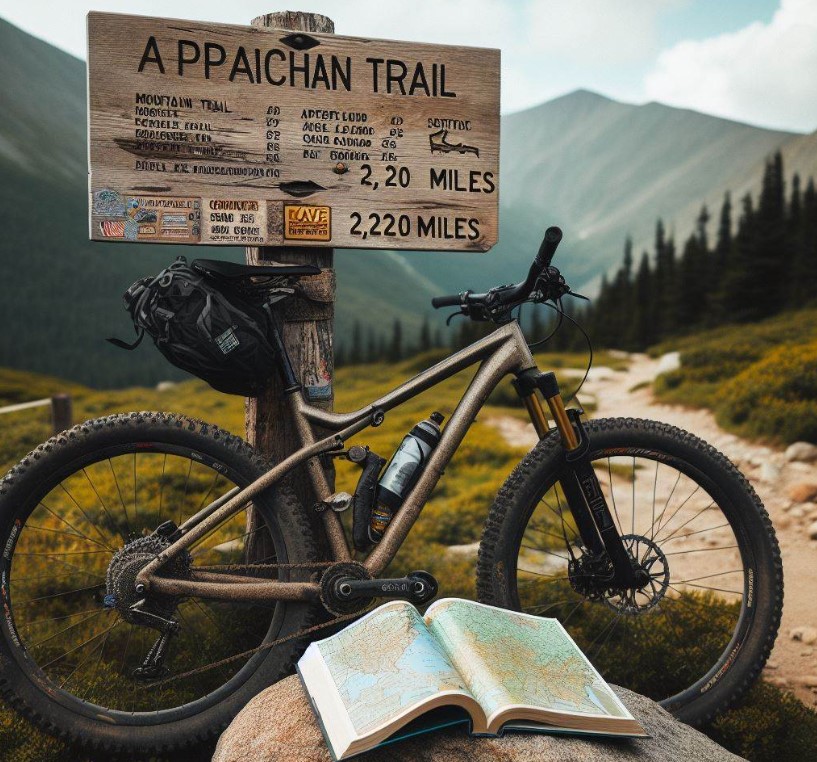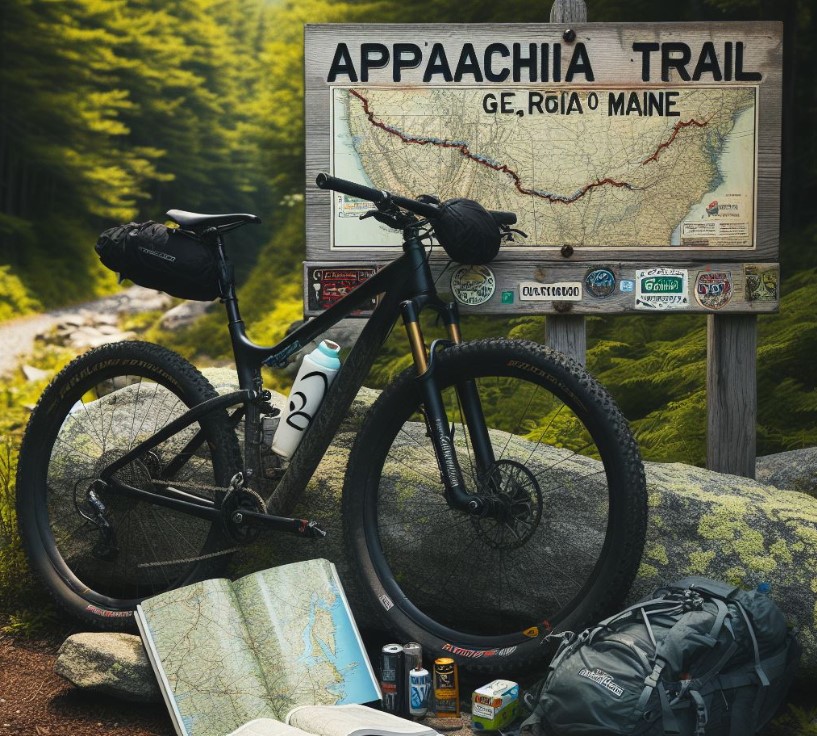Can You Cycle The Appalachian Trail? Answered
Are you looking for Can You Cycle The Appalachian Trail? Exploring the possibility of cycling the Appalachian Trail (AT) opens up a discussion on the balance between adventure and environmental conservation. This revered trail, known for its challenging terrain and stunning landscapes, draws thousands of hikers annually. But does it offer a path for cyclists? This exploration delves into regulations, alternatives, and the essence of outdoor ethics in the context of cycling through America’s iconic wilderness.
Key Takeaways
- Cycling on the Appalachian Trail is generally prohibited to preserve the trail’s natural state and ensure the safety of hikers.
- Specific sections outside the official AT corridor may allow cycling, offering alternative routes for enthusiasts.
- Understanding and respecting the trail’s regulations is crucial for both conservation efforts and enjoying the surrounding nature.
Can You Cycle The Appalachian Trail?
No, you cannot cycle the Appalachian Trail. The AT is designated primarily for hiking to preserve its natural state and ensure the safety of its users.

Exploring the Alternatives
While the Appalachian Trail itself may not welcome wheels, the regions surrounding it boast a network of bike-friendly trails. These alternatives offer cyclists the chance to explore the Appalachian region’s beauty without infringing on the AT’s hiker-first policy.
Bike-Friendly Routes Near the AT
The East Coast Greenway and the Great Allegheny Passage are prime examples of trails offering cyclists a blend of scenic views and physical challenges, reminiscent of the AT experience.
These routes are designed with cyclists in mind, featuring wider paths and smoother terrains, making them a suitable alternative for those looking to explore the Appalachians on two wheels.
Regulations and Access
Understanding the regulations governing these alternative routes is essential. Each trail has its own set of rules regarding usage, conservation efforts, and cyclist behavior.
Respecting these guidelines ensures these paths remain open and enjoyable for all users, promoting a harmonious relationship between cyclists, hikers, and nature.
The Impact of Cycling on Trails
Cycling on natural trails can have a significant environmental impact. It’s crucial to discuss the implications of introducing bikes to paths primarily designed for foot traffic.
Conservation Concerns
The wear and tear from bike tires can accelerate erosion and damage fragile ecosystems. The Appalachian Trail and similar paths traverse through diverse habitats, home to various wildlife species. Preserving these environments is paramount, requiring careful consideration of human activities allowed on these trails.
Safety and Trail Etiquette
Safety is another major concern. The narrow, often rugged paths of the Appalachian Trail are not designed to accommodate both cyclists and hikers simultaneously.
Promoting trail etiquette and understanding between different types of trail users is essential for preventing accidents and ensuring everyone’s experience is positive and respectful.
Equipment and Preparation for Appalachian Cycling
For those seeking cycling adventures in the Appalachian region, selecting the right equipment and preparing adequately cannot be overstated.
Choosing the Right Bike
Mountain bikes are the preferred choice for tackling the varying terrains of the Appalachian region. Their design caters to rugged landscapes, offering durability and comfort over long distances. Additionally, cyclists should consider gear tailored for multi-day trips, emphasizing lightweight and versatile equipment.
Training and Physical Preparation
The physical demands of cycling in mountainous terrain require thorough preparation. Building endurance through regular, long-distance rides and incorporating strength training into your routine are key steps in ensuring a successful and enjoyable cycling experience.
Cycling Events and Community
The cycling community around the Appalachian region is vibrant and welcoming. Participating in organized events or joining local cycling clubs can enhance your experience, offering opportunities for adventure, learning, and camaraderie.
Organized Rides and Races
Annual events such as the Assault on Mount Mitchell and the Shenandoah Mountain 100 provide structured challenges for cyclists of all levels.
These events not only test your mettle but also immerse you in the rich landscapes and communities that make the Appalachian region unique.
Local Cycling Clubs and Groups
Joining a local cycling club can be a gateway to discovering the best routes, gaining valuable insights, and making lifelong friends. These communities thrive on sharing experiences and advocating for cycling-friendly initiatives, making them an invaluable resource for any cyclist.
Can You Do Appalachian Trail On Bike?
Cycling the Appalachian Trail (AT) is not permitted. The AT is designed and maintained as a footpath for hiking, spanning from Georgia to Maine. This regulation helps to preserve the trail’s natural condition and ensure the safety of hikers.

It also protects the surrounding ecosystems from the potential damage that biking could cause, such as soil erosion and habitat disturbance.
However, for cycling enthusiasts looking to experience the Appalachian region, there are alternative trails and routes specifically designed for biking that offer a similarly challenging and rewarding experience.
What Is The Longest Bike Trail In The US?
The longest bike trail in the US is the Great American Rail-Trail. This ambitious, coast-to-coast trail project is designed to connect existing paths and trails into a single, 3,700-mile route from Washington, D.C., to Washington State.
The trail aims to provide a seamless, safe, and scenic pathway for cyclists, hikers, and runners alike. Unlike the Appalachian Trail, which is primarily for foot traffic, the Great American Rail-Trail is being developed with cyclists in mind, making it a significant endeavor in creating accessible, long-distance, non-motorized travel routes across the United States.
Are Dirt Bikes Allowed On The Appalachian Trail?
Dirt bikes and other motorized vehicles are strictly prohibited on the Appalachian Trail. The AT is preserved as a non-motorized trail to ensure the safety of hikers and to protect the natural environment it traverses.
The ban on motorized vehicles, including dirt bikes, helps minimize noise pollution, soil erosion, and disturbances to wildlife, maintaining the serene and untouched nature of the trail.

For off-road motorcycling enthusiasts, there are designated areas and trails throughout the United States that are specifically designed to accommodate motorized vehicles, ensuring both conservation efforts and recreational needs are met.
What’s The Appalachian Trail Of The Bicycle Touring World?
The TransAmerica Bicycle Trail is often considered the Appalachian Trail of the bicycle touring world. Established in 1976 by the Adventure Cycling Association, this iconic bike route stretches over 4,200 miles from Astoria, Oregon, to Yorktown, Virginia.
It offers cyclists the opportunity to experience the vast and diverse landscapes of the United States, from the Pacific Ocean, through the Rocky Mountains, to the Atlantic Coast.
The trail passes through small towns, national parks, and historic sites, providing a comprehensive and immersive touring experience. Designed specifically for long-distance cyclists, the TransAmerica Trail challenges and rewards its travelers in much the same way the Appalachian Trail does for hikers.
Conclusion
While the Appalachian Trail itself remains a hiker’s paradise, inaccessible to cyclists, the surrounding regions offer a wealth of bike-friendly trails that promise adventure and breathtaking beauty.
These alternatives not only respect the sanctity of the AT but also cater to the spirit of exploration that cyclists seek. By embracing these routes, cyclists can experience the splendor of the Appalachian region without compromising the trail’s integrity or their adventurous ambitions.
People Also Ask
How can cyclists contribute to the conservation of the Appalachian region?
Cyclists can contribute to conservation by sticking to designated trails, practicing leave-no-trace principles, participating in trail maintenance days, and supporting local and national conservation organizations. Being mindful of their environmental impact and advocating for sustainable cycling practices helps protect the natural beauty of the Appalachian region for future generations.
Can you camp along bike-friendly trails in the Appalachian region?
Yes, many bike-friendly trails in the Appalachian region have designated camping areas along or near the routes. It’s important to research and follow local regulations regarding camping, including fire management, waste disposal, and wildlife safety practices.
How does trail etiquette differ for cyclists and hikers?
Trail etiquette for cyclists includes yielding to hikers and equestrians, announcing their presence when approaching from behind, and staying on designated paths. Both cyclists and hikers should share the trails respectfully, leaving no trace of their visit to preserve the natural environment.
Are there any organized cycling events in the Appalachian region?
Yes, the region hosts several organized cycling events, such as the Assault on Mount Mitchell and the Shenandoah Mountain 100. These events cater to various skill levels, offering challenges through some of the most picturesque landscapes in the area and fostering a sense of community among participants.

Welcome to the exhilarating world of Matt Rex, a professional car racer turned renowned vehicle enthusiast. Immerse yourself in his captivating blog as he shares heart-pounding adventures, expert reviews, and valuable insights on cars, trucks, jets, and more. Fuel your passion for speed and discover the beauty of vehicles through Matt’s engaging stories and meticulous expertise. Join the ever-growing community of enthusiasts who find inspiration and expert advice in Matt Rex’s blog—a digital hub where the thrill of speed meets the pursuit of knowledge.






